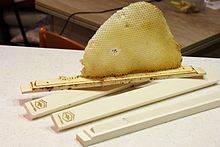Top bar hive
Kenyan Top Bar Hive (KTBH or upper carrier prey ) is a relatively new type of beehive ( prey ) that the aid was developed under the direction of the bee scientist Gordon F. Townsend from the Canadian Guelph University for Africa. The underlying system goes back to the traditional Macedonian beehive (Northern Greece).
description
The honeycomb arrangement and the type of installation are similar to the original African, lying or horizontally hanging tubular hives. The advantages lie in the relatively simple production. There is only one dimension that must be adhered to precisely, which describes the width of the upper beam and indicates the distance from the center of the honeycomb to the center of the honeycomb of parallel honeycombs. Upper beams are the strips loosely placed on top. The bees pull out their combs downwards at a central orientation (wax strips or edge). The honeycombs can be freely lifted, moved and removed with the upper beams. Worldwide there is a trend towards top bar hives, especially in the hobby area in industrialized countries, especially for setting up in the home garden. In English you can also find the name Backyard-hive - Hintergarten-Beute.
The Top-Bar-Hive offers the following advantages for hobbyists:
- Little expenditure of time, since the complex provision of frames is not necessary.
- Little space required, as no storage space for frames and empty beehive parts (frames) and workrooms are necessary in the cold months. Stored honeycombs must also be protected against wax moths .
- Avoidance of pre-stamped wax center walls in the frames, in which residues from mite control can accumulate due to their greasy properties.
- By working all the honeycombs at one height, beekeeping is particularly easy, as no heavy honeycombs have to be moved.
- Almost all work steps can be carried out exactly as in a trough hive or other beehives.
For use in the hobby area, a wire mesh floor is usually built in for easier detection of bee parasites ( Varroa ). In addition, the bee entrances (flight holes) are often not designed as many small openings, as in Africa, which can be more easily defended against enemies by a few bees, since this is not necessary in Europe and North America. Many beekeepers also build windows in the sides so that they can watch the bees undisturbed.
literature
- Friedrich Ruttner : Natural history of the honey bee . Kosmos Publishing House. Stuttgart 2003. ISBN 3-440-09477-4 .
- Mavrofridis G. & I. Th. Anagnostopoulos : The First Top Bar Hive with Fully Interchangeable Combs , 2012. American Bee Journal 152 (5): 483-485.
Web links
Individual evidence
- ↑ HV Harissis, G. Mavrofridis: A 17th Century Testimony On The Use Of Ceramic top bar hives . In: Bee World . tape 89 , no. 3 , January 2012, ISSN 0005-772X , p. 56-58 , doi : 10.1080 / 0005772x.2012.11417481 .
